I have always been a tea lover, and oolong tea is one of my favorites. It has a unique taste that sets it apart from other teas.
Oolong tea is a traditional Chinese tea that is made from the leaves of the Camellia sinensis plant. It is a partially oxidized tea, which means that it is somewhere between a green tea and a black tea.
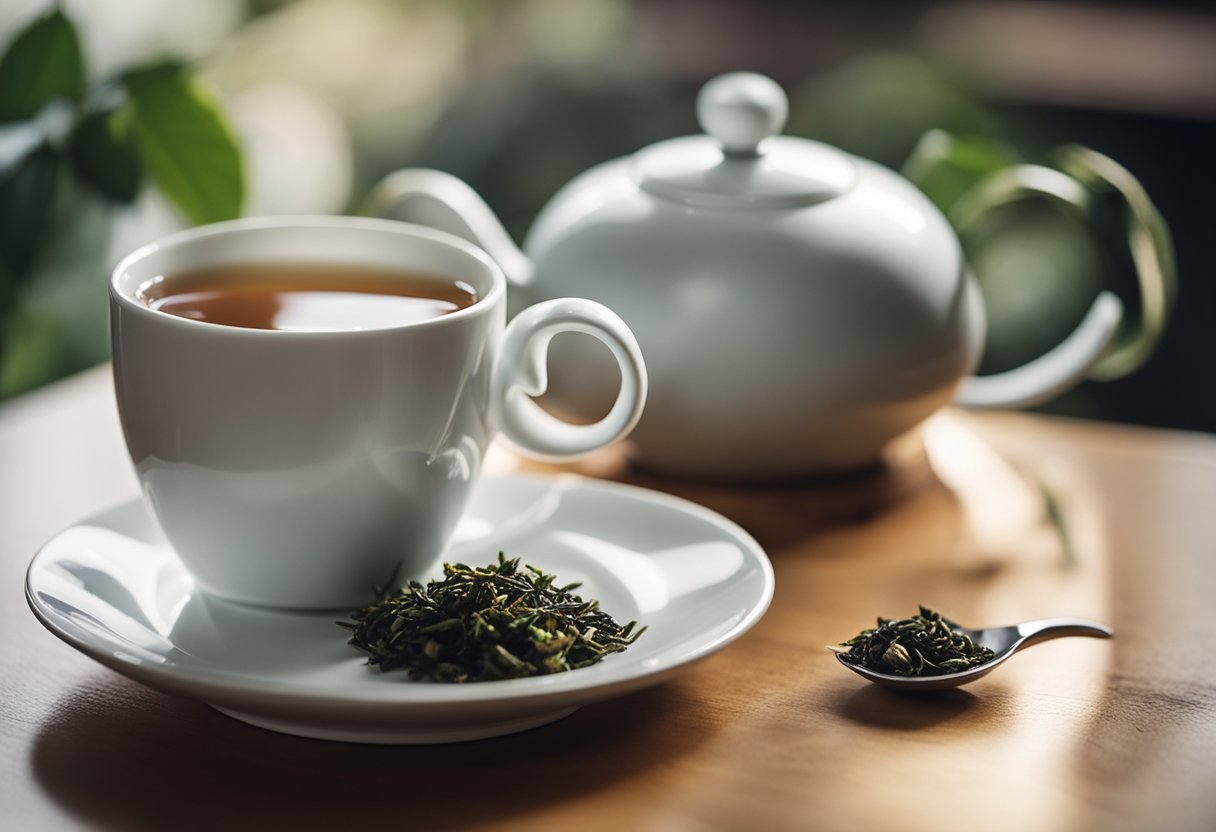
The taste of oolong tea can vary depending on the type of tea and the way it is processed. Some oolong teas have a floral and fruity taste, while others have a nutty and roasted flavor. The taste can also be affected by the region where the tea is grown and the altitude at which it is grown.
Key Takeaways
- Oolong tea is a traditional Chinese tea that is partially oxidized, making it somewhere between a green tea and a black tea.
- The taste of oolong tea can vary depending on the type of tea, the way it is processed, and the region where it is grown.
- Oolong tea can have a floral and fruity taste or a nutty and roasted flavor.
Understanding Oolong Tea
As a tea enthusiast, I have tried many different types of tea, but oolong tea has always been one of my favorites.
Oolong tea is a partially oxidized tea that sits between green tea and black tea on the oxidation scale. It is made from the leaves of the Camellia sinensis plant, the same plant used to make all traditional Chinese teas.
Oolong tea is known for its complex and nuanced flavor profile. Depending on the specific type of oolong tea, it can have a range of flavors from floral-fruity to woody to deep chocolate and creamy nuts. The taste of oolong tea can also vary depending on the level of oxidation and the processing method used.
One of the unique characteristics of oolong tea is its withering process. After the leaves are harvested, they are withered to remove moisture. This step is common in producing Chinese tea and is crucial in determining the final flavor of the tea.
Another important aspect of oolong tea is its caffeine content. Oolong tea contains less caffeine than black tea but more than green tea. The amount of caffeine in oolong tea can vary depending on the specific type of oolong tea and the brewing method used.
In summary, oolong tea is a partially oxidized tea with a complex and nuanced flavor profile. It is made from the leaves of the Camellia sinensis plant and undergoes a withering process after harvesting. The caffeine content in oolong tea varies depending on the specific type and brewing method.
Oolong Tea Origin
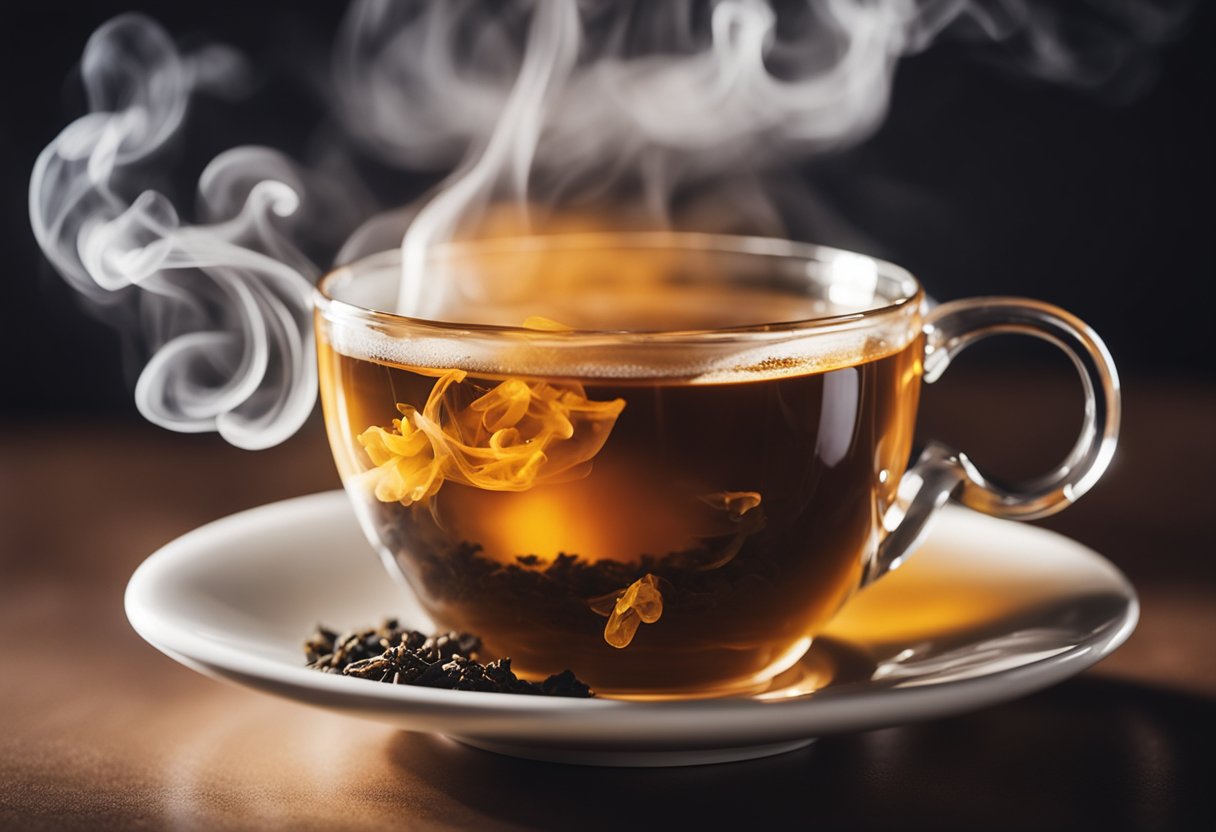
Oolong tea, also known as Wulong or Wu long tea, is a traditional Chinese tea that has been consumed for centuries. The name “oolong” means “black dragon” in Chinese, which is a reference to the dark, long, and curly appearance of the tea leaves.
Oolong tea is believed to have originated in China’s Fujian Province, specifically in the Wuyi Mountains, where the tea bushes grow in a unique microclimate. The Wuyi Mountains are known for their rocky terrain, which provides excellent drainage for the tea bushes and contributes to the distinctive flavor of the tea.
However, oolong tea is also produced in other regions of China, such as Guangdong province, which is known for its Phoenix Dan Cong oolong tea.
Taiwan is also a major producer of oolong tea, particularly in the central mountainous region of the island. Taiwanese oolong teas are often characterized by their floral and fruity notes, as well as their smooth and creamy texture.
The production process of oolong tea is complex and involves partial oxidation of the tea leaves, which gives the tea its unique flavor profile. The level of oxidation can vary depending on the type of oolong tea and the producer’s preference, ranging from light and floral to dark and smoky.
In conclusion, oolong tea has a rich history in China and Taiwan, and its unique flavor profile is a result of the specific growing conditions and production processes used in these regions. Whether you prefer a light and floral oolong or a dark and smoky one, there is an oolong tea out there that is sure to satisfy your taste buds.
Oolong Tea Processing
Oolong tea is a semi-oxidized tea that is known for its unique taste and aroma. The processing of oolong tea involves several steps that are crucial in determining the final flavor and aroma of the tea. In this section, I will discuss the different steps involved in oolong tea processing.
Withering
The first step in oolong tea processing is withering. This step involves allowing the freshly plucked tea leaves to wither for several hours. During this process, the leaves lose their moisture content and become soft and pliable. The withering process is critical in developing the unique flavor and aroma of oolong tea.
Rolling
After withering, the tea leaves are rolled to shape them into the desired form. Rolling helps to break down the cell walls of the leaves and release the enzymes that are responsible for oxidation.
The rolling process also helps to shape the leaves into the desired form, which can be either long and twisted or rolled into small balls.
Oxidation
Oxidation is a crucial step in oolong tea processing. During this process, the enzymes released during rolling react with oxygen in the air to produce the unique flavor and aroma of oolong tea.
The level of oxidation can vary depending on the type of oolong tea being produced. For example, lightly oxidized oolongs have a floral and fruity flavor, while heavily oxidized oolongs have a more robust and earthy flavor.
Roasting
Roasting is the final step in oolong tea processing. During this step, the tea leaves are roasted over charcoal to stop the oxidation process and lock in the flavor and aroma of the tea. The roasting process can also add a smoky flavor to the tea, depending on the intensity of the roasting.
In conclusion, oolong tea processing involves several critical steps that are crucial in determining the final flavor and aroma of the tea. The withering, rolling, oxidation, and roasting processes all play a significant role in developing the unique taste and aroma of oolong tea.
The Taste of Oolong Tea
Oolong tea is a unique type of tea that falls between green and black teas in terms of oxidation. The flavor of oolong tea can vary greatly depending on the type of oolong tea, the region it was grown in, and the processing method used.
Generally, oolong tea has a complex flavor profile with a balance of floral, fruity, and earthy notes. The taste can range from light and delicate to dark and robust, depending on the level of oxidation.
Lightly oxidized oolong teas have a fresh and floral flavor with a hint of sweetness, similar to green tea. They may have notes of honey, orchid, or jasmine, and a creamy mouthfeel.
On the other hand, dark oolong teas are more oxidized and have a stronger, richer flavor that is similar to black tea. They may have notes of citrus, spice, or even chocolate.
One of the unique characteristics of oolong tea is its ability to be re-steeped multiple times, with each steeping revealing different flavors and aromas. This makes it a great tea for savoring and exploring its intricate taste profile.
While oolong tea can have a slight bitterness, it is usually balanced by its natural sweetness and other flavors. Some oolong teas may also have a slightly astringent finish, which can be attributed to the tannins present in the tea leaves.
In summary, the taste of oolong tea is complex and diverse, with a range of flavors and aromas that can vary depending on the type of oolong tea, the region it was grown in, and the processing method used. Whether you prefer a light and delicate tea or a dark and robust one, oolong tea has something to offer for every tea lover.
Brewing Oolong Tea
Brewing oolong tea is a simple process, but it requires attention to detail to bring out the tea’s unique flavor. Here are some tips to help you brew the perfect cup of oolong tea.
Water Temperature
One of the most important factors in brewing oolong tea is water temperature. Oolong tea is more delicate than black tea, but not as delicate as green tea. Therefore, the water temperature should be around 190-200°F (87-93°C). If the water is too hot, it can scorch the tea leaves and ruin the flavor.
Steeping Time
The steeping time for oolong tea can vary depending on the type of oolong tea you are brewing. Generally, oolong tea should be steeped for around 3-5 minutes.
However, some oolong teas can be steeped for up to 10 minutes. It’s important to follow the instructions on the package or experiment with different steeping times to find the perfect balance of flavor.
Infuser
Using an infuser is a great way to brew oolong tea. An infuser is a small mesh or metal ball that holds the tea leaves while they steep in the water. The infuser allows the water to flow freely through the tea leaves, which helps to release the flavor.
Tea Kettle
A tea kettle is a great tool for brewing oolong tea. A tea kettle heats the water to the perfect temperature and allows you to pour the water directly over the tea leaves. This helps to ensure that the tea leaves are evenly saturated with water, which helps to bring out the flavor.
In conclusion, brewing oolong tea is a simple process that requires attention to detail. By following these tips, you can brew the perfect cup of oolong tea every time.
Health Benefits of Oolong Tea
I have researched the health benefits of oolong tea, and I am confident in saying that it has several potential health benefits. Oolong tea is a great source of antioxidants, which can help protect the body against free radicals that can cause damage to cells.
Studies have shown that oolong tea may help improve heart health by reducing the risk of heart disease. This is due to the presence of polyphenols, which can help reduce inflammation and lower cholesterol levels.
Oolong tea may also help regulate blood pressure and improve blood sugar control, which can be beneficial for those with type 2 diabetes.
Oolong tea contains caffeine, which can help boost metabolism and increase fat oxidation. This can lead to weight loss and a reduction in body fat. Additionally, oolong tea may help improve cognitive function and reduce the risk of developing certain types of cancer.
In addition to its potential health benefits, oolong tea is also a great source of vitamins and minerals, including iron. It is a great alternative to sugary drinks and can be enjoyed as a hot or cold infusion.
It is important to note that while oolong tea has several potential health benefits, it should not be used as a cure-all or substitute for medical treatment. As with any dietary supplement, it is important to consult with a healthcare professional before incorporating oolong tea into your diet.
Different Types of Oolong Tea
As we discussed earlier, oolong tea is a partially oxidized tea that falls between green and black tea. The level of oxidation varies depending on the type of oolong tea. In this section, I will introduce you to some of the most popular types of oolong tea and their taste profile.
Iron Goddess of Mercy
Iron Goddess of Mercy, also known as Tie Guan Yin, is a light oolong tea that is highly popular in China. It has a floral and orchid-like aroma with a sweet and slightly creamy taste. This tea is perfect for those who prefer a light and refreshing tea.
Oriental Beauty
Oriental Beauty, also known as Bai Hao Oolong, is a heavily oxidized tea that is grown in Taiwan. It has a fruity and honey-like flavor with a hint of cinnamon. This tea is perfect for those who prefer a sweet and fruity tea.
Da Hong Pao
Da Hong Pao, also known as Big Red Robe, is a heavily roasted tea that is grown in the Wuyi Mountains of China. It has a smoky and earthy flavor with a hint of caramel. This tea is perfect for those who prefer a bold and robust tea.
Wuyi Tea
Wuyi Tea, also known as Rock Tea, is a heavily roasted tea that is grown in the Wuyi Mountains of China. It has a rich and complex flavor with a hint of floral and a smoky finish. This tea is perfect for those who prefer a strong and bold tea.
Honey Oolong
Honey Oolong is a lightly oxidized tea that is grown in Taiwan. It has a sweet and floral aroma with a hint of honey. This tea is perfect for those who prefer a sweet and delicate tea.
Sencha
Sencha is a Japanese green tea that is lightly steamed and has a grassy and vegetal taste. It is not technically an oolong tea, but it is often compared to lightly oxidized oolong teas. This tea is perfect for those who prefer a light and refreshing tea.
In conclusion, oolong tea comes in a variety of types, each with its own unique taste profile. Whether you prefer a light and refreshing tea or a bold and robust tea, there is an oolong tea out there for you.
Packaging and Storage of Oolong Tea
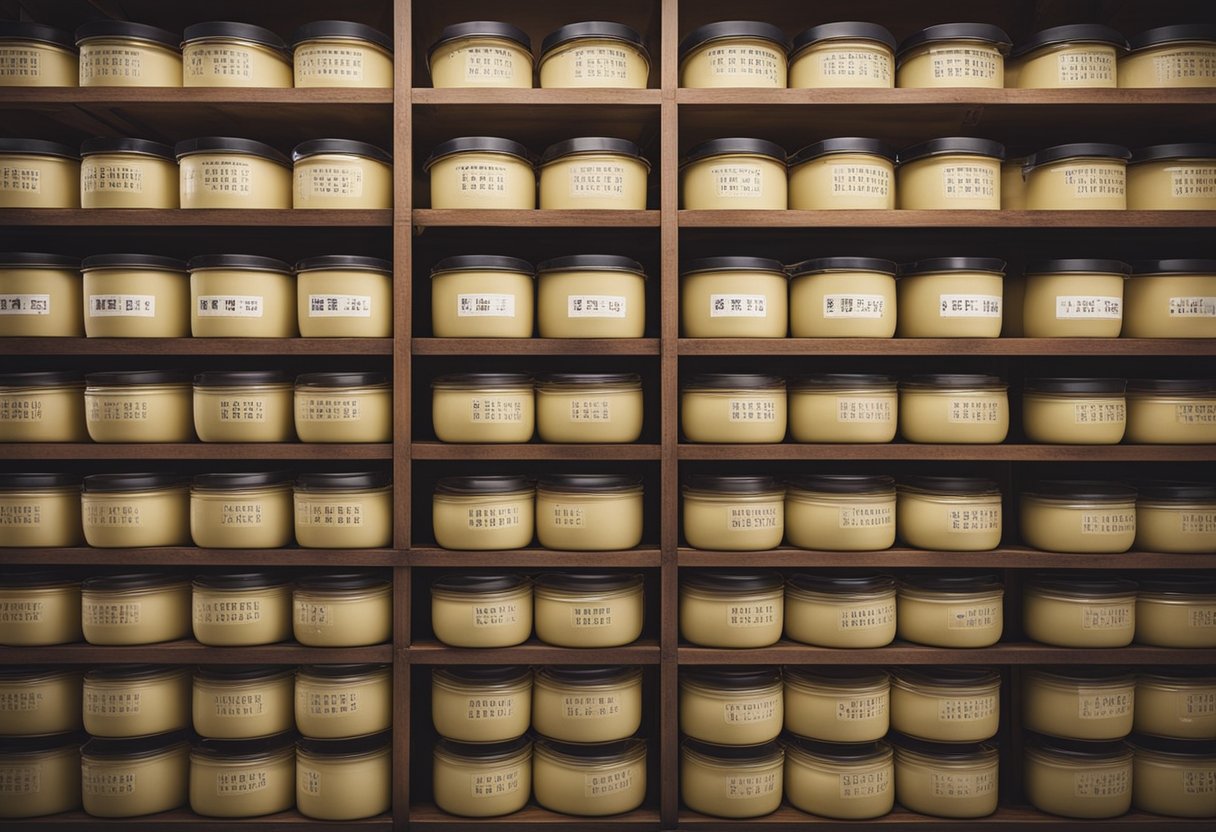
When it comes to oolong tea, packaging and storage are crucial factors that can affect the taste and quality of the tea. As an avid tea drinker, I have learned the importance of proper packaging and storage to preserve the flavor and aroma of my oolong tea.
One of the best ways to store oolong tea is in an airtight container. This will prevent air and moisture from affecting the tea leaves and altering the flavor.
I prefer using a tin or glass container with a tight-fitting lid to store my oolong tea. This helps to keep the tea fresh and flavorful for a longer period of time.
Another important factor to consider when storing oolong tea is the temperature. Oolong tea should be stored in a cool, dry place away from direct sunlight.
Exposure to heat and light can cause the tea leaves to deteriorate and lose their flavor. Therefore, it is best to store oolong tea in a pantry or cupboard, away from the stove or any other heat source.
When it comes to packaging, loose-leaf oolong tea is the best option. Loose-leaf tea allows the tea leaves to expand and release their full flavor and aroma.
It also allows for better quality control, as you can inspect the leaves for any signs of damage or pests. Old oolong tea can still be used, but it may not have the same flavor profile as fresh tea.
It is also important to note that oolong tea can age like wine, developing a deeper and richer flavor over time. However, this is only true if the tea is stored properly.
If oolong tea is exposed to air, moisture, or heat, it can become stale and lose its flavor. Therefore, it is important to store oolong tea properly to ensure that it ages well and retains its flavor.
In summary, proper packaging and storage are essential for preserving the flavor and aroma of oolong tea. Airtight containers, cool and dry storage, loose-leaf tea, and avoiding exposure to heat and light are all important factors to consider when storing oolong tea.
By following these guidelines, you can ensure that your oolong tea stays fresh and flavorful for a longer period of time.
Oolong Tea Vs Other Teas
As a tea enthusiast, I have tried many different types of teas, including green teas, black teas, and even coffee. However, oolong tea has always stood out to me as a unique and flavorful option.
Here are some key differences between oolong tea and other types of teas:
Flavor Profile
Oolong tea has a distinct flavor profile that sets it apart from other teas. It has a complex, floral taste with notes of fruit and honey.
The level of oxidation in oolong tea can vary, which affects its flavor. Lightly oxidized oolong teas, such as green oolong, have a fresh, grassy taste similar to green tea. On the other hand, heavily oxidized oolong teas, such as black dragon, have a rich, robust flavor similar to black tea.
Green tea, on the other hand, has a fresh, vegetal taste with a slight bitterness. It is often described as having a grassy or seaweed-like flavor.
Black tea has a bold, robust taste with notes of malt and sometimes astringency. Coffee has a bitter, nutty flavor with varying levels of acidity and bitterness depending on the roast and brewing method.
Caffeine Content
Oolong tea falls somewhere in the middle when it comes to caffeine content. It has less caffeine than black tea but more caffeine than green tea. This makes it a great option for those who want a moderate caffeine boost without feeling jittery.
Green tea has the least amount of caffeine of the three, making it a good choice for those who are sensitive to caffeine. Black tea has the most caffeine, making it a popular choice for those who want a stronger caffeine boost. Coffee, of course, has the most caffeine of them all.
Brewing Method
The brewing method for oolong tea is different from other types of teas. Oolong tea is best brewed with full-boiling water for short amounts of time. This method brings out the complex flavors and aromas of the tea without making it bitter.
Green tea, on the other hand, is best brewed with water that is just below boiling to avoid making it bitter. Black tea is best brewed with full-boiling water for a longer period of time to bring out its bold flavor. Coffee is typically brewed with hot water that is just below boiling for several minutes.
Overall, oolong tea offers a unique and complex flavor profile that sets it apart from other types of teas. Its moderate caffeine content and unique brewing method make it a great option for those looking for a flavorful and energizing beverage.
Potential Side Effects of Oolong Tea
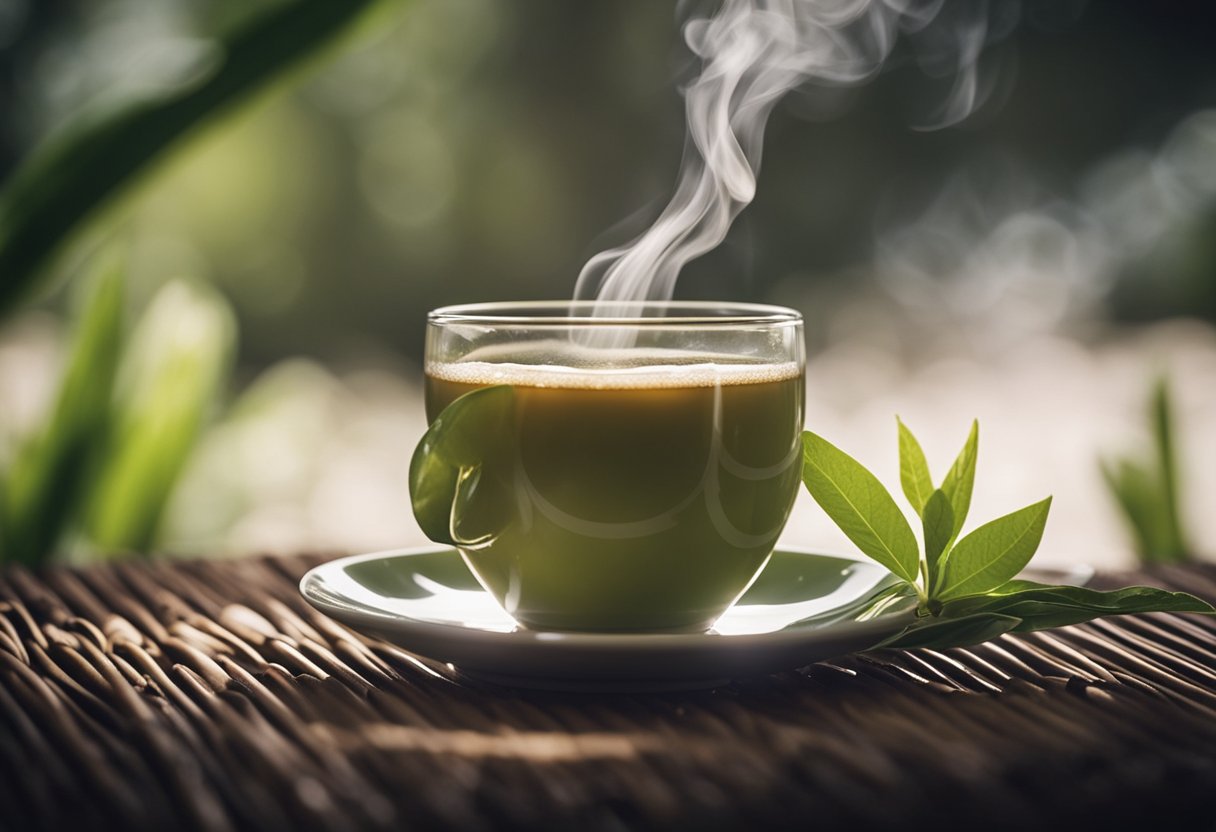
As with any other tea or beverage, oolong tea may have some potential side effects that you should be aware of. While oolong tea is generally safe for most people, some individuals may experience adverse reactions to it. Here are some potential side effects of oolong tea:
- Insomnia and Restlessness: Oolong tea contains caffeine, which is a natural stimulant that can cause insomnia and restlessness in some people. If you are sensitive to caffeine, you may want to limit your intake of oolong tea or avoid it altogether.
- Addiction: Oolong tea contains caffeine, which can be addictive. If you consume large amounts of oolong tea on a regular basis, you may become dependent on it and experience withdrawal symptoms when you try to quit.
- Pregnancy and Breastfeeding: Oolong tea may have negative effects on pregnant and breastfeeding women. It may cause harm to the fetus or infant, and it may also interfere with the absorption of certain nutrients. Therefore, it is best to avoid oolong tea during pregnancy and breastfeeding.
- Children: Oolong tea may have negative effects on children. It may cause hyperactivity, irritability, and other behavioral problems. Therefore, it is best to limit children’s intake of oolong tea.
- Frequent Urination: Oolong tea is a natural diuretic, which means that it can increase urine production and cause frequent urination. If you have a bladder or kidney condition, you may want to avoid oolong tea or limit your intake.
- Arrhythmia: Oolong tea may cause irregular heartbeats in some people. If you have a heart condition or are taking medication for a heart condition, you should consult with your doctor before consuming oolong tea.
- Reduced Thiamine Absorption: Oolong tea contains tannins, which can interfere with the absorption of thiamine, or vitamin B1. If you consume large amounts of oolong tea on a regular basis, you may be at risk for thiamine deficiency.
- Weakened Bones: Oolong tea may weaken bones and increase the risk of osteoporosis. This is because it contains fluoride, which can accumulate in the bones and cause them to become brittle over time.
In conclusion, while oolong tea is generally safe for most people, it may have some potential side effects that you should be aware of. If you experience any adverse reactions to oolong tea, you should stop consuming it and consult with your doctor.
Oolong Tea in Different Cultures
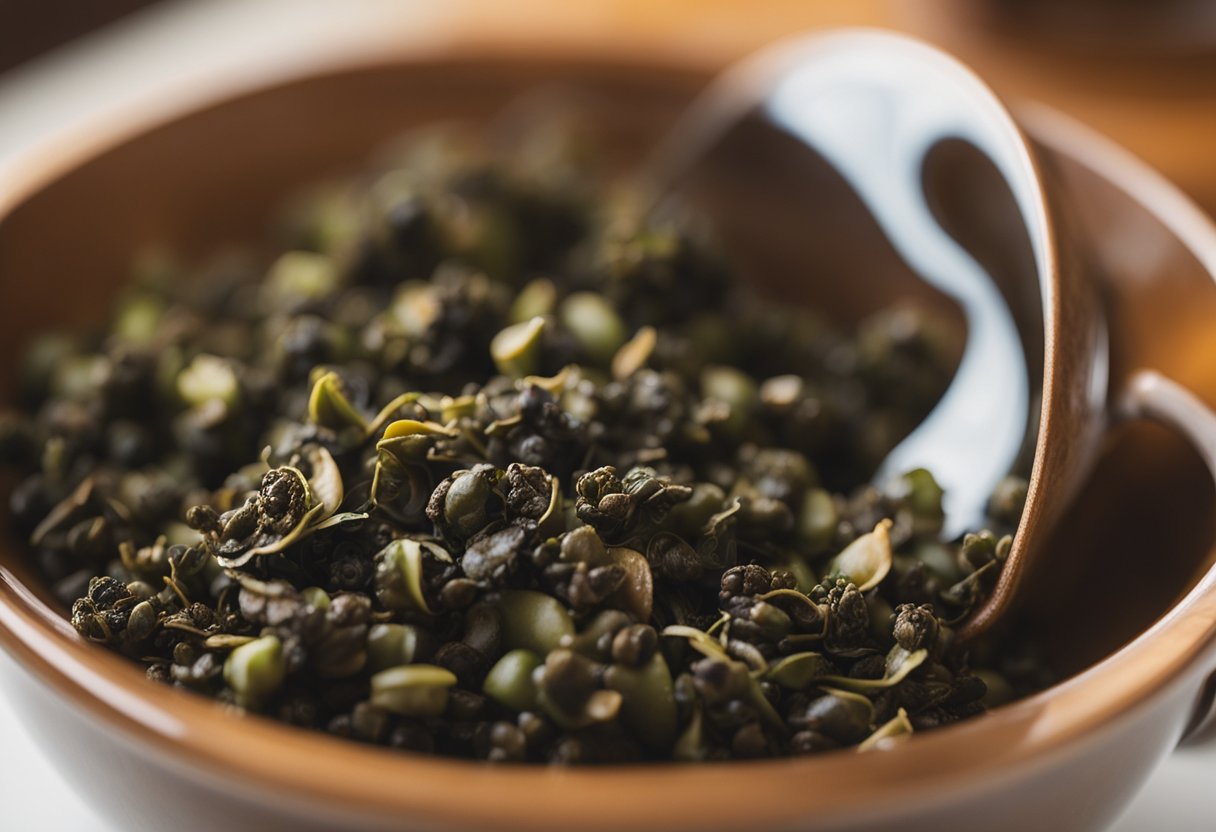
Oolong tea is a popular tea variety that is consumed in many cultures around the world. Here are some of the ways that oolong tea is enjoyed in different parts of the world:
China
Oolong tea has a long history in China, where it is known as Wulong tea. It is grown and produced in several regions of China, including Fujian, Guangdong, and Taiwan.
In China, oolong tea is often enjoyed during formal tea ceremonies, as well as in everyday life. It is typically served plain, without any added sugar or milk.
Japan
While green tea is the most popular tea variety in Japan, oolong tea is also enjoyed by some. In Japan, oolong tea is often served in restaurants and cafes, and it is sometimes used as an ingredient in cocktails and other beverages.
Japanese oolong tea is typically less oxidized than Chinese oolong tea, which gives it a lighter flavor and aroma.
Vietnam
Oolong tea is also popular in Vietnam, where it is known as trà ô long. Vietnamese oolong tea is often brewed with lotus flowers, which gives it a unique flavor and aroma. It is typically served hot, and it is sometimes sweetened with honey or sugar.
Overall, oolong tea is a versatile tea variety that is enjoyed in many different cultures around the world. Whether you prefer it plain or with added flavorings, oolong tea is a great choice for tea lovers everywhere.
The Complexity of Oolong Tea
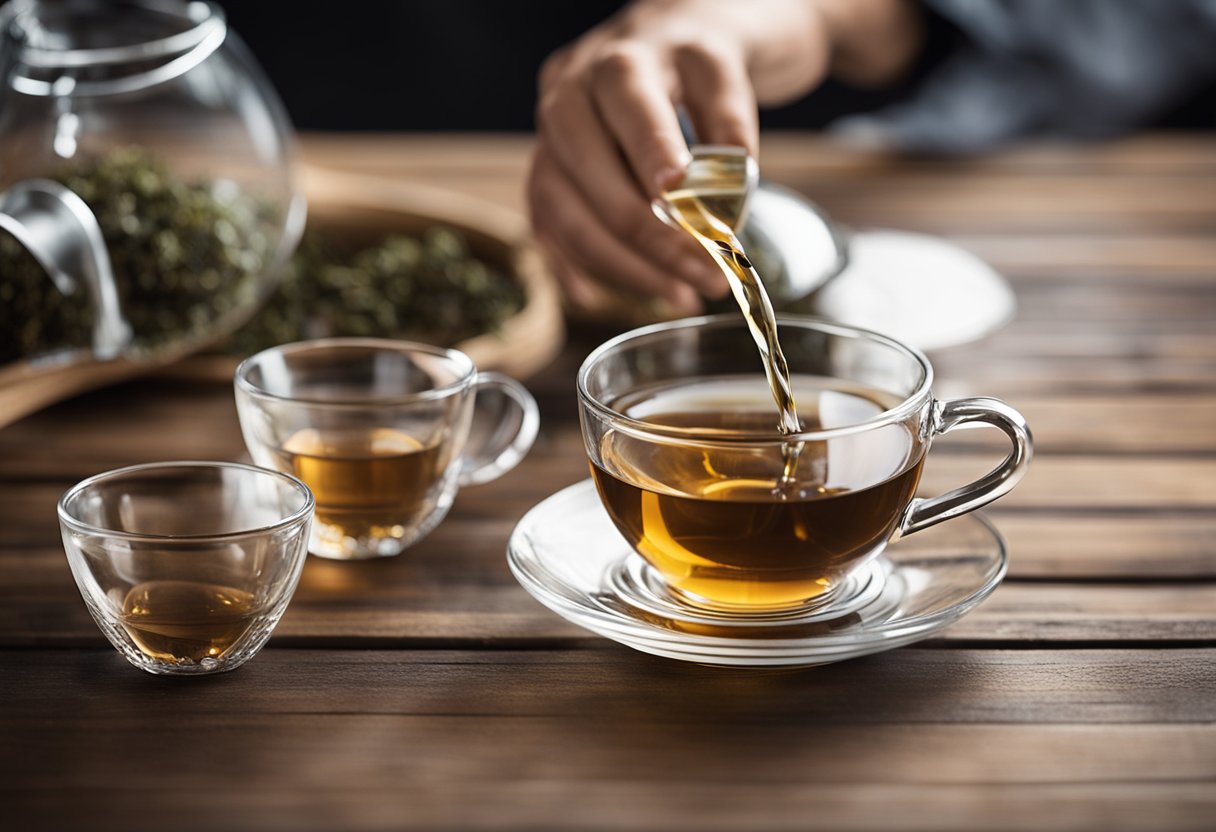
As an avid tea drinker, I have always been drawn to the complexity of oolong tea. Oolong tea is unique in that it is partially oxidized, which gives it a flavor profile that is somewhere between green tea and black tea.
One of the most fascinating aspects of oolong tea is its complexity. Oolong tea can have a wide range of flavors, from floral and fruity to woody and nutty.
This complexity is due to the fact that oolong tea can be produced in a variety of shapes, including rolled, curled, and twisted. Each shape can affect the flavor and aroma of the tea.
Another factor that contributes to the complexity of oolong tea is terroir. Like wine, the region where oolong tea is grown can have a significant impact on its flavor. Oolong tea is primarily grown in China and Taiwan, and each region produces tea with a slightly different flavor profile.
For example, oolong tea from the Wuyi Mountains in China is known for its smoky, mineral flavor, while oolong tea from Taiwan is often more floral and fruity.
Overall, the complexity of oolong tea is what makes it such a fascinating and enjoyable beverage. Whether you prefer a light, floral oolong or a rich, nutty oolong, there is a type of oolong tea out there for everyone.
Oolong Tea and Weight Loss
As someone who has been drinking oolong tea for a while, I can attest to its weight loss benefits. Oolong tea is known to boost fat oxidation, which means it helps your body burn fat more efficiently.
This is because oolong tea contains caffeine and catechins, which are both known to increase metabolism and promote weight loss.
Studies have shown that drinking oolong tea can help increase metabolism by up to 10%. This means that your body will burn more calories even when you are at rest. In addition, oolong tea has been found to block the absorption of fats and carbohydrates, which can further aid in weight loss.
One of the most significant benefits of oolong tea is its ability to help with weight loss in a healthy and sustainable way. Unlike crash diets or weight loss pills, oolong tea promotes weight loss without putting stress on your body. This makes it a safe and effective way to lose weight.
It is important to note that drinking oolong tea alone will not lead to significant weight loss. However, when combined with a healthy diet and regular exercise, oolong tea can be an excellent addition to your weight loss routine.
In summary, oolong tea can be a helpful tool in promoting weight loss. Its ability to boost metabolism, increase fat oxidation, and block the absorption of fats and carbohydrates make it a safe and effective way to lose weight.
However, it is important to remember that oolong tea should be used in conjunction with a healthy diet and regular exercise for best results.
Oolong Tea and Minerals
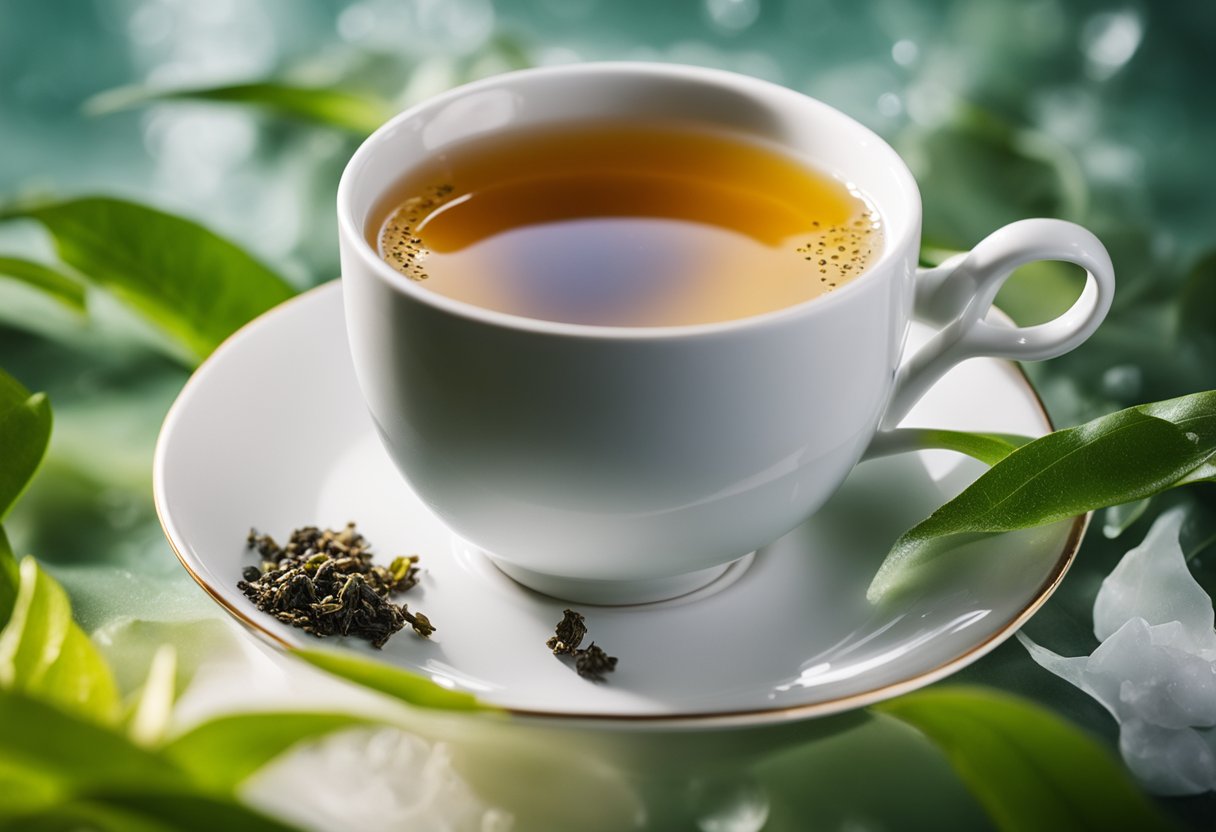
I have always been interested in the nutritional benefits of food and beverages. Oolong tea is known to contain minerals that are beneficial to our health. In this section, I will discuss the minerals found in oolong tea and their potential health benefits.
Iron
Iron is an essential mineral that plays a crucial role in the body. It is required for the production of red blood cells, which carry oxygen throughout the body.
Oolong tea contains a small amount of iron. However, the amount of iron in oolong tea is not significant enough to meet the daily recommended intake. Therefore, it is important to consume other iron-rich foods to meet our daily requirements.
Magnesium
Magnesium is an important mineral that is required for over 300 biochemical reactions in the body. It is important for maintaining a healthy immune system, regulating blood sugar levels, and maintaining healthy bones. Oolong tea contains a moderate amount of magnesium.
Drinking oolong tea regularly can help increase our magnesium intake and potentially improve our overall health.
Calcium
Calcium is a mineral that is essential for maintaining healthy bones and teeth. It also plays a role in muscle function and nerve transmission. Oolong tea contains a small amount of calcium.
However, the amount of calcium in oolong tea is not significant enough to meet the daily recommended intake. Therefore, it is important to consume other calcium-rich foods to meet our daily requirements.
Potassium
Potassium is a mineral that is important for maintaining healthy blood pressure levels. It also plays a role in muscle function and nerve transmission. Oolong tea contains a small amount of potassium.
However, the amount of potassium in oolong tea is not significant enough to meet the daily recommended intake. Therefore, it is important to consume other potassium-rich foods to meet our daily requirements.
In conclusion, oolong tea contains minerals that are beneficial to our health. While the amounts of iron, calcium, and potassium in oolong tea are not significant enough to meet our daily requirements, drinking oolong tea regularly can help increase our magnesium intake and potentially improve our overall health.
Oolong Tea and Colors
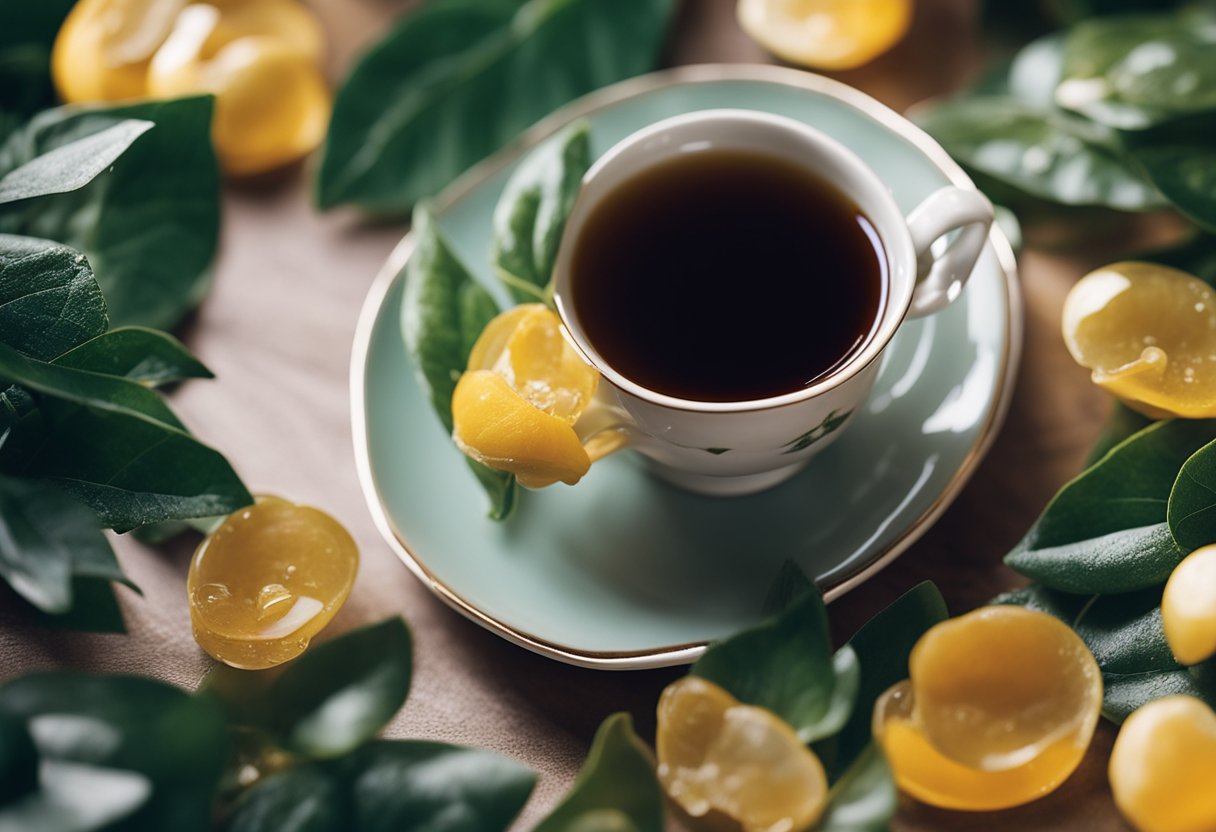
As an avid tea drinker, I have always been fascinated by the colorful world of tea. Oolong tea is no exception when it comes to the variety of colors it can take on. Depending on the level of oxidation, oolong tea can range from a light green to a dark amber or even reddish-brown color.
The color of oolong tea is a result of the processing method used. After harvesting, the tea leaves are withered, which removes moisture and reduces the water content.
This step is common in producing Chinese tea. The next step is to bruise the leaves to start oxidation. The level of oxidation determines the color and flavor of the tea.
Lightly oxidized oolong teas, such as green oolong, tend to have a bright green or yellow color and a fresh, floral taste. On the other hand, fully oxidized oolong teas, such as dark oolong, can have a bold, rich flavor similar to black tea and a darker amber or reddish-brown color.
It is important to note that the color of oolong tea does not necessarily indicate its quality or taste. A light-colored oolong tea can have a complex and nuanced flavor profile, while a darker-colored oolong tea can be mellow and smooth. The taste of oolong tea is subjective and can vary from person to person.
In summary, oolong tea can take on a range of colors, from light green to dark amber or reddish-brown, depending on the level of oxidation. The color of oolong tea does not necessarily indicate its quality or taste, as the taste can vary greatly regardless of the color.
Frequently Asked Questions
What are the different types of oolong tea?
There are several types of oolong tea available, each with a unique flavor profile. Some popular types of oolong tea include:
- Tie Guan Yin: This type of oolong tea has a floral aroma and a sweet taste.
- Da Hong Pao: This oolong tea has a rich, woody flavor with a hint of fruitiness.
- Wuyi Yancha: This type of oolong tea has a smoky flavor with a fruity finish.
Where can I find the best oolong tea?
The best oolong tea can be found in specialty tea shops or online. Look for high-quality loose leaf oolong tea that has been sourced from reputable tea gardens.
What are some flavor pairings that go well with oolong tea?
Oolong tea pairs well with a variety of foods, including:
- Fruits: Try pairing oolong tea with peaches, apricots, or pears.
- Spices: Oolong tea goes well with cinnamon, cardamom, and ginger.
- Chocolate: The rich, complex flavor of oolong tea pairs well with dark chocolate.
How does the taste of oolong tea compare to black tea?
Oolong tea has a more complex flavor profile than black tea. It is less astringent and has a smoother, more nuanced taste. Oolong tea also has a floral or fruity aroma that is not typically found in black tea.
What makes oolong tea unique?
Oolong tea is unique because of the way it is processed. The tea leaves are partially oxidized, which gives oolong tea its distinctive flavor profile. Oolong tea is also unique because it can be steeped multiple times, with each steeping bringing out different flavors and aromas.
Can you add milk to oolong tea?
While it is possible to add milk to oolong tea, it is not traditionally served that way. Oolong tea is best enjoyed on its own, without any added milk or sweeteners.







